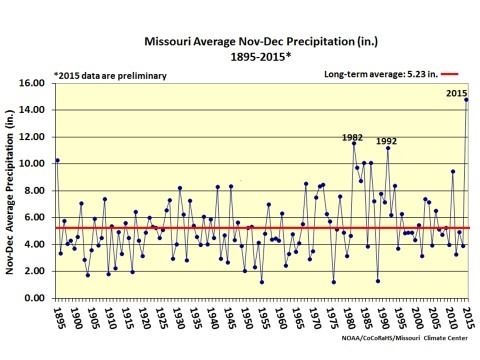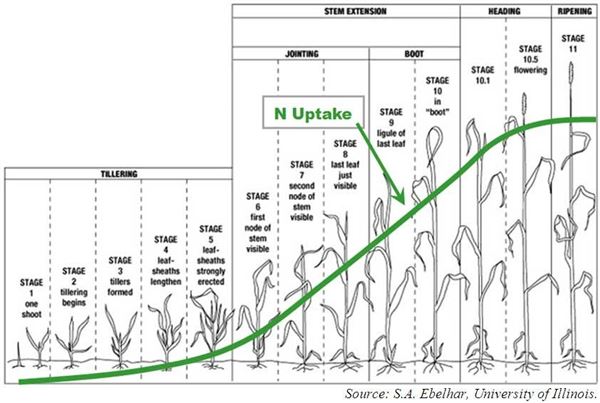|
Unprecedented Rainfall, Flooding And Impact On Wheat And Cover Crops
GREGORY A. LUCE
COLUMBIA, MO.
There have been many questions concerning winter wheat and cover crops that have been subjected to the adverse effects of flooding. With the unprecedented rainfall in the last two months across Missouri (see chart on right), many winter wheat and cover crop fields have been flooded or saturated for varying periods in portions of the state. The impact that flooding, waterlogging and potential ice sheeting may have on the winter crops could be significant. As with most weather related events, the level of impact will need to be judged on a field by field basis yet there are some important factors to keep in mind.
Crop injury from waterlogging and ice sheeting is primarily caused by the lack of oxygen. A main concern of the flooding is the impact on the growing point of wheat which is below ground until after tillering. The growing point is subject to water saturation or ice cover and the amount of oxygen available to plant tissues below the surface of the soil decreases as plants and microorganisms use up what is available. The depletion of oxygen in saturated soil is dependent on a number of factors, but temperature is a very important factor.
At higher temperatures the rate of oxygen depletion is greater. For instance, during summer conditions, the oxygen level in flooded/saturated soil reaches the point that is harmful to plant growth after 48 to 96 hours. Water-logging also leads to accumulations of CO2, which can actually be harmful to plants in high concentrations. Research and observations suggest that most crop plants submerged for more than five to seven days, when temperatures are greater than 65 degrees, will die and that yield can be impacted by flooding after as few as 48 hours. Under cooler temperatures, the negative effects of flooding take longer to impact plant tissues, so we can reasonably expect winter wheat to tolerate flooding for a longer time than described above for midsummer conditions.
Dormancy of wheat, or cover crops like cereal rye, greatly reduces the requirement for oxygen but does not eliminate it. With the warm December, the winter crops were not dormant when the wet weather began. Considering the extreme conditions, it seems reasonable that some stand loss is expected in the areas where water saturation or ice sheeting remains for long periods. However, before writing off a winter wheat crop that has been flooded, or ice covered, experience has taught me that wheat is very resilient. I would suggest that growers confirm wheat viability by bringing a sample inside a warm building and observing it for regrowth after a couple of days. This could be done later in the winter, prior to green-up. If, after exhibiting new leaf growth, the plants also sprout new white roots, a grower can be relatively assured that the sampled area holds some live plants. If the plant is in good condition, the crown will appear white and healthy, and new roots will be developing. At green-up, field scale decisions will need to be made. The critical threshold for a wheat grain field is an average of 12 to 15 live plants per square foot. Below that level replant is needed.
Wheat requires a chilling period called vernalization in order for wheat to move from tillering into the reproductive stages. After tillers have formed, and vernalization occurs through the winter period, wheat plants enter the “greening up” phase and begins erect growth, Feekes 4, and is closely followed by Feekes 5.
During green-up, Feekes growth stage 4-5, it is an optimal time to make spring topdress nitrogen applications and to apply post-emergence herbicides for weed control. Feekes growth stage 4-5 also is an important time to scout for soilborne virus diseases and early-season foliar diseases such as powdery mildew and leaf blotch.
Questions have also been raised about nitrogen losses from the soil. Excessive water can cause denitrification and leaching of nitrate nitrogen beyond the rooting zone of the developing plant, particularly in lighter-textured soils. Soil temperatures below 50 F slow the nitrification and denitrification processes, so loss of nitrogen at this point may not be significant. Also, most nitrogen tends to be applied to wheat in the spring anyway. To maximize yield response in winter wheat, the majority of nitrogen fertilizer should be applied before jointing takes place. The chart shows the rapid uptake of nitrogen from Feekes 6 to 10.
Right now it is good to understand the processes involved from flooding and ice covered conditions on the wheat crop. Be prepared to address the potential stand issues at green-up and determine if it is justified to keep a stand for grain, and if nitrogen or weed control is needed. ∆
GREGORY A. LUCE: Adjunct Instructor, Division of Plant Sciences, University of Missouri


|
|